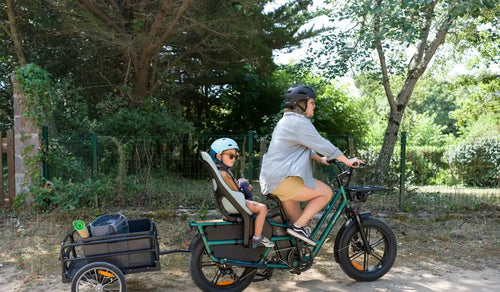Many people are adopting electric bikes for their eco-friendliness, convenience, and entertaining riding experience. Electric bikes become even more entertaining when used for outdoor activities. However, the rising popularity of riding electric bikes in natural environments has caused people to question their legality in state parks. So, in this article, we will answer the question: Are electric bikes allowed in state parks? We will look at the regulations across different state parks and offer insights for electric bike owners.

Electric Bike Definition and Classification
An electric bike is a bicycle with an electric motor fitted that assists the rider in peddling or provides full throttle. Pedelec Electric bikes require the rider to pedal to activate the motor, amplifying their efforts. Electric bikes with throttles don't require the rider to pedal, so the experience is similar to riding a scooter.
The different types of electric bike classifications impact where you can ride to them. For example, throttle electric bikes may not be permitted on specific trails where pedelecs are allowed. It is essential to understand these differences before you take your electric bike to a state park to stay within the park's regulations.
How Classifications Affect Public Land Use
Electric bikes fall into three categories, affecting where you can ride them. Generally, you can ride a Class 1 electric bike in most places. These have a limited top-assisted speed of 20 mph. Class 2 electric bikes are also limited to 20 mph and can sometimes be allowed on bike paths and specific trails but often face more restrictions. Class 3 electric bikes are faster, with a limited top speed of 28 mph. These electric bikes have more restrictions due to their higher speeds. These classifications help manage the impact on trails, safety, and user experience in shared spaces.
Legal Framework for Electric Bikes
At the federal level, electric bikes are classed similarly to traditional bikes as long as they meet specific criteria. The standards set by the Consumer Product Safety Commission (CPSC) determine the performance and construction of electric bikes. For example, according to federal law, an electric bike cannot exceed the maximum power output of 750 W and cannot go faster than 20 mph on motor power alone.
Organizations like the League of American Bicyclists and PeopleForBikes advocate for uniform regulations across states, promoting safe and legal e-bike use nationwide. These organizations work to educate policymakers, land managers, and the public about the benefits of e-bikes and the need for consistent regulations.

Electric Bike Policies in State Parks
Electric bike policies vary significantly in different states. Here are some examples:
California
You can ride electric bikes on bike paths, multi-use trails, and roads unless expressly provided. Californian state parks like Lake Tahoe Basin Management Unit and Mount Tamalpais Pace State Park have specific guidelines that favor people riding electric bikes, particularly those in Class 1. In Yosemite National Park, e-bikes are permitted on paved bike paths but not dirt trails. This ensures that the park's delicate ecosystems remain protected. Meanwhile, Redwood National and State Parks allow e-bikes on designated bike paths and roads, providing ample opportunities for exploration.
Colorado
In Colorado, Class 1 and 2 electric bikes can be ridden on bike paths, but they are restricted on off-road trails. For example, in Golden Gate Canyon State Park, they can be ridden on paved roads but not on dirt trails. This approach aims to balance recreation with conservation, ensuring that both e-bike riders and nature lovers can enjoy the park.
New York
The state of New York has recently legalised electric bikes on most trails and roads. However, there are some restrictions on electric bikes with throttles. If you wanted to ride in Hudson Highlands State Park, you could only ride your e-bike on unpaved trails, as this is seen to promote eco-friendly exploration.
The differences between states often come from environmental concerns, safety issues, and user experience. For example, electric bikes can erode trails much faster than regular bikes due to their extra weight and power. Therefore, their usage is restricted. Additionally, the higher speeds and increased traffic on popular trails promote safety concerns, leading to varied policies in electric bike use.
Tips and Considerations for Visiting E-bike-friendly Parks
Visiting electric bike-friendly state parks can be a fantastic experience. But it's best to be prepared to ensure you have the best time possible while staying safe. Here are our top tips:
Check Regulations Before You Go
Before you head to a state park with your electric bike, we recommend that you check the electric bike policy of that park. This is because policies can vary, and you can easily fall foul of the regulations, which could land you in trouble.
Plan Your Route
It's essential to know which trails are suitable for electric bikes and permit them. Most state parks have detailed maps online and at visitor centers indicating suitable electric bike routes.
Make Sure You Have The Appropriate Bike
Not all electric bikes are suited to off-road riding. Off-road trails are usually graded according to their difficulty and style, so make sure your electric bike is capable of coping with the trails you are planning to ride. For example, an electric cargo bike would not be suitable for technical off-road terrain.
Know Your Own Capabilities
One of the great things about riding an electric bike is that it can take you to new places previously inaccessible. However, ensure you have the skills and fitness to handle your planned route. It's easy to misjudge the terrain and get out of your depth or run out of battery power a long way from home.
Pack Essentials
If you plan on riding all day, ensure you have plenty of water snacks and a first-aid kit. It is also a good idea to carry a tool kit for minor repairs, a spare inner tube, a pump, and tire levers. You may also want to take an extra battery or charger if you're going to ride a long distance.
You should also be prepared for changing weather conditions by carrying suitable clothing and checking the weather forecast.
Stay Safe
Always wear a helmet when riding your electric bike. You may also want to carry lights if you are going to ride early or late in the day. It's also essential to check your bike over before leaving to ensure it is in full working order.
Staying safe also includes knowing about the local area. Be sure to educate yourself on wildlife and plants you may come across that may compromise your safety.
Leave No Trace
Stay on designated trails to minimize your environmental impact. Carry out all trash and leave nature as you found it. Don't be the person to leave behind old inner tubes and sandwich wrappers.

Fiido T2 Longtail Cargo E-bike
Multifunctional&family-friendly cargo ebike with endless possibilities.
Fiido Electric Bikes and Outdoor Adventures
Fiido is an electric bike company with a range of products suitable for riding in state parks. By choosing the right Fiido Electric bike, you will have a robust and powerful machine that can handle various terrains. The best products in Fiido's range for this type of riding are their fat tire electric bikes.
If you want to carry lots of things for your day out, you may want to consider the Fiido T2. This electric cargo bike has lots of load carrying capacity and a powerful motor. The motor, combined with its high-traction tires, makes the T2 ideal for a day out in a state park. Alternatively, if you prefer something a little more rugged, why not check out the Fiido M1 Pro? This electric bike also has flat tires, but it is also agile and powerful, creating an entertaining riding experience on loose surfaces. In addition to this, it has a folding frame that makes it easy to transport in your car to the park.
Fiido is an electric bike company that provides its products with suitable features for riding in state parks. Here is what you can expect:
Durability: Fiido e-bikes are built to withstand various weather conditions and terrains, making them ideal for state parks.
Battery Life: Long-lasting batteries ensure you can explore without worrying about running out of power.
Comfort: Ergonomic designs and adjustable components provide a comfortable ride, even on longer journeys.
Safety: High-quality brakes, lights, and other safety features enhance your riding experience.
Summary
With all the advantages electric bikes provide, it is no wonder they're becoming so popular. While the regulations regarding usage vary by state, many state parks permit and welcome electric bikes as long as you stick to their specific guidelines. It is important to understand these regulations before heading to a state park in order to stay safe and out of trouble.
A Fiido Electric bike is perfect for outdoor adventures in state parks. Its versatility and eco-friendliness make it ideal for exploring natural spaces, while its durability gives you peace of mind. Check out fiido.com to see their excellent range of electric bikes suitable for riding in state parks.














